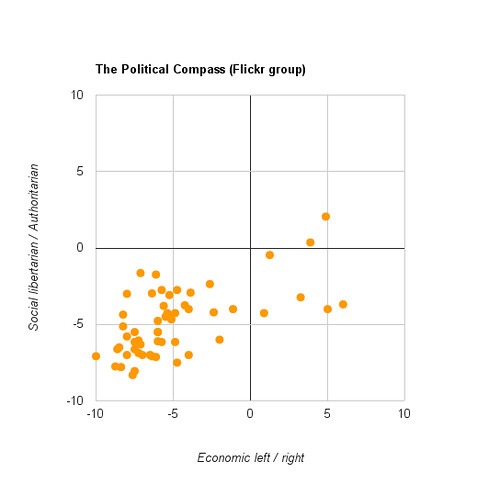Monday, 31 October 2011
Day 4: Crombie
Sunday, 30 October 2011
Day 3: Carnoustie
Saturday, 29 October 2011
Day 2: Lenzie
Friday, 28 October 2011
Day 1: Dave
We ran into someone who was very familiar-looking in our first pub, but I dismissed my suspicions only to subsequently find out we'd been sitting next to someone we went to high school with. D'oh.
Wednesday, 26 October 2011
Political Compass
Sunday, 23 October 2011
Cephalopod fantasy
(For full disclosure: this isn't as big a step/concession as I'm making out. The novel is centred around my favourite invertebrate group, and begins in the sumptuous setting of a former employer.)
Billy Harrow, a curator at the Natural History Museum in London, is not having a good week. While conducting a public tour of the specimen collection he discovers that its prize entry, a 8.6 m Architeuthis that Billy himself curated, has completely vanished. Worse, a new "specimen" has appeared among the assembled preservation jars: a man folded neatly, if tightly, into a glass vessel. But Billy's troubles are only just beginning. The disappearance of one bottled animal, coupled with the appearance of another, attracts the attention of Baron and Collingwood, members of a specialist, and secretive, police unit that deals with less-than-natural occurrences. They reveal to Billy the existence of a Kraken cult that reveres the giant squid, a member of which, Dane Parnell, is also NHM staff. But Dane and his fellow worshippers aren't the only third parties interested in iconic giant molluscs, nor are they even remotely the most outlandish. Before long, Billy finds himself on a journey through a London that he barely recognises, where ancient spirits live in statues, where squirrels are unionised, and where the sea itself is a god.
Wow. While it would be fair to say that this novel hasn't won me over to fantasy, I was pretty entertained, and regularly astonished, by the imagination on display. It starts like a completely conventional, if somewhat bizarre, mystery story with a missing cephalopod for its McGuffin, but after only a few pages the more fantastical elements begin to creep in. By the end of the novel, it's wall-to-wall deviation-from-reality. What was most impressive was how consistently Miéville ups the ante on with his outlandish occurrences. At first, his Kraken cult alone seemed pretty off-the-wall, but this was trumped time and time again, with the late appearance of the Sea as an active force as a particular high point in outlandishness.
My favourite of Miéville's creations was probably Wati, an Egyptian spirit who was originally confined to a statue on a pharoh's whim, but is now free to roam all statues, including, enjoyably strangely, a Captain Kirk action figure. What made him even more appealing was that this otherworldliness was then combined with a more mundane role as a union leader, initially drawn into the action because of a strikebreaking squirrel. I also really liked the disrespectful, and slightly sultry, telepathic police officer, Collingwood, whose feigned disinterest and sharp, text-speak insults really brightened things up. Though I did think that, after giving her a great entrance, Miéville didn't really use her anywhere near enough in the latter two thirds of the book.
There's a "But" in all this, however. One that applies to all of the fantasy that I can remember reading, including classics like LotR. Namely that the underlying rules to which the novel is working are either flexible or completely absent. Characters die but can be brought back; inescapable situations suddenly have secret backdoors; mundane objects are revealed as powerful table-turners. Essentially, deus ex machina is the defining feature of the genre. After a certain point, the fun drains away when you realise that the corner into which the author has just painted his characters is probably something that can be (will be) got around with a few deft strokes of the pen. And, conversely, it can create situations where the reader might not unreasonably expect a reversal that never actually comes.
Here, Miéville gets passed this - in a way - by being so imaginative in his "cheating". I never really got anything like that sinking feeling I had in LotR when the Dead Men of Dunharrow were plucked out of thin air to turn the final battle in The Return of the King. While science fiction has its fair share of deus ex machina, it usually tries to play more fairly within its own rules, and often bends over backwards to retrospectively explain any "gods" that appear to have popped out from beneath the sofa cushions. Which, I guess, is why I prefer it as a fantastical genre: the real world conforms to rules, so I expect it of my fiction too. The wholesale abandonment of this in fantasy is what irks me, at least in part because I suspect that it's just lazy writing. A skilful author might very well construct an emotionally resonant scene in which the reader fears for characters they've come to love, but it seems slapdash when that's resolved by a cheap sleight of hand.
Anyway, the upshot of all this is that, while I have my reservations, I really enjoyed Kraken. I don't know that I'll be visiting Miéville's fantasies again any time soon, but it's difficult not to recommend any novel so consistently innovative in its creations, especially one in which a cephalopod plays such a pivotal role.
Friday, 21 October 2011
Multidecadal variation
Thursday, 20 October 2011
Winter is upon us
Spring, defined here at Strange News as the first day that fingerless gloves are worn in preference to full gloves, is anticipated to arrive in late February or early March 2012.
Monday, 17 October 2011
Winkworth & Mottisfont
Winkworth & Mottisfont, a set on Flickr.
We spent both days this passed weekend ticking off nearly-local National Trust sites. Got to make that membership pay for itself.
Our first stop was Winkworth Arboretum up in Surrey. It was pretty good, though not as bathed in autumn colours as we'd hoped. It was also somewhat lacking in the tearoom facilities that we've come to expect from the NT - no lemon drizzle cake (or decent sandwiches) here. Lunch was instead provided by nearby Godalming (home of the Nosmo King sign).
Sunday saw us out passed Romsey at Mottisfont Abbey. Not that you'd know it was a former abbey these days. The abbey, or parts of it anyway, have been almost entirely subsumed within a manor house exterior. It's quite something to see an arch or medieval wall hidden in a corner of an otherwise stately-seeming home. In a change from Saturday, dining was of a high standard (if matched by similarly high prices).
Sunday, 16 October 2011
A week in films
Easy A
Another enjoyable counter-example to my (ill-informed) no-films-for-girls observation from earlier this year. Emma Stone plays a funny (if somewhat unrealistically self-conscious) teenager whose white lie to avoid an undesirable camping trip takes on a life of its own in the gossip of her high school. Turning her new-found, and ill-founded, reputation as a tramp (US-sense) to her advantage, she becomes the go-to girl for boys keen to trade cash to "gain" sexual experience. But with consequences. Anyway, the film is played very well and is wry, witty and full of laughs, particularly when her super-liberal and super-supportive parents get screentime.
Grade: B+ (+2 on the Leeper Scale)
American History X
By contrast, and quite a surprising one, AHX is a badly acted, overly didactic, unrealistic mess of a film. It was well-received in some quarters when originally released (if subject to a hissy fit by its director), but it's difficult to see why, except in that it engages headlong with the theme of racism. But the film does so bluntly (dinner table discussions of racism) and artlessly (black-and-white for the past - I mean, really?), and wastes the talent on show. Very disappointing.
Grade: D+ (high -2 on the Leeper Scale)
His Girl Friday
I'd been waiting to see this film for years, in large part because a favoured author reverentially borrowed the name of its lead female character for his protagonist. It's a screwball comedy telling the story of a newspaper editor's nefarious scheming to win back his journalist ex-wife, played out alongside the events of one night in which a befuddled prisoner on death row escapes and unsettles the re-election prospects of a corrupt, incumbent mayor. But while fast-paced, and full of gallows humour, much of which is at the expense of the press, the film feels seriously dated and rather stagey (which, I've just discovered, is because it's a translated stage-play). It also has a few moments in it that disturb modern sensibilities, such as when the all-white cast nod along ("political correctness gone mad") to the suggestion that the prisoner only got the death penalty because he shot a black police officer. Disappointing, but not a waste.
Grade: C+ (high 0 on the Leeper Scale)
Midnight in Paris
Owen Wilson plays a Hollywood screenwriter, and Woody Allen proxy, who time-shifts to his idolised 1920s Paris, along the way discovering that so-called Golden Ages only appear that way when looked at in the rear mirror. While much of the press is presently gushing about this being a welcome return to past form for Woody Allen, I don't think that he's ever fully dropped the ball. To be fair, I haven't seen all of his films of the past decade, but I've probably seen most of them and none of those have been stinkers. To my mind, he's actually one of the most reliable of directors, even if his films aren't always (or ever?) cutting-edge "high art". Anyway, this was a very enjoyable, and gentle, love letter to Paris, with a central line on nostalgia that's difficult to disagree with, and a lot of good gags about figures of the time. It also made me remember how much I like wandering the streets of Paris - though, unlike the film, I prefer it sans pluie.
Grade: B+ (+2 on the Leeper Scale)
Tron: Legacy
A bit of a lazy delve into the past with this one. It doesn't do anything interesting in sequelising its fictional world, but unlike, say, The Matrix (which arguably borrowed a bit from the original Tron) it doesn't ruin it either (yes, I'm looking at you Reloaded / Revolutions). It's largely a superfluous if mildly entertaining retread of the original, which is only really engaging when Jeff Bridges does his Zen thing (though it does contain a surprising turn from Michael Sheen as an uber-camp entertainment program). The film does miss a trick, however, in failing to connect the real-world malevolence of corporate software giant ENCOM with that of Clu in the virtual-world, a theme that was more important in the original film. But the film isn't derailed by this, and just ambles along in a likeable enough fashion. Given that The Matrix more stylishly treads on similar ground, it's difficult to see what more could be done with Tron's world, but a bit more effort from the writers wouldn't have gone amiss. Amiably dull.
Grade: C (0 on the Leeper Scale)
Wednesday, 12 October 2011
"Least Concern"
Today's Featured Picture over at Wikipedia shows a giraffe grazing, and discusses adaptations for consuming spiky plants. Not knowing an awful lot about giraffes, but wondering how they were doing extinction-wise, I moseyed on over to the article on them and was duly reassured that they are classified by the IUCN as "Least Concern". However, sticking around to read up on "the tallest of all extant land-living animal species", I discovered that, across the entirety of Africa, there are fewer giraffes (of all species combined) than there are people living in Southampton. In fact, given the uncertainties involved in counting them, there could be considerably fewer.
All of which got me thinking about how the classification of "Least Concern" seems, at best, pretty relative (i.e. of least concern compared to most other species), and may give an overly rosy view of their status to skim-readers such as (usually) myself. I can't establish from Wikipedia how many giraffes were roaming Africa, say, 10,000 years ago, but I'd be surprised if it wasn't an order of magnitude more (for loose comparison, I did discover that there were ~300,000 African Bush Elephants when I was born, but there are only 10,000 now). That said, and knowing next to nothing about it, I would imagine that population viability is probably pretty good at the ~100,000 level (hence, presumably, "Least Concern").
Leaving that genetic aspect aside, given that land-use changes (i.e. more for humans, less for everything else) show no sign of altering direction at any point in the foreseeable (and not-so-foreseeable) future, I seriously doubt that the current giraffe population level is even faintly secure. To be fair, the term "Least Concern" is accurate: relative to many other species, giraffes are not immediately on their way out so, yes, we should be less concerned about them. But given this low population plus likely future change, and given that humans (7,000,000,000 and counting) are also formally classified as "Least Concern", it doesn't strike me as a helpful categorisation.
Sunday, 9 October 2011
Half-life
It did, however, finish with a rather confusing item about a developing technology for dealing with nuclear waste that transmutes radioisotopes with long half-lives into others that decay much more quickly. This sounds like a good idea when you first hear it - get rid of pollution faster - but it doesn't quite make sense. Paradoxically, the longer a radioisotope takes to decay, the safer it is since it gives off less radiation per unit time. When one hears of nuclear waste that will take tens of thousands of years (or more) to decay, you're really hearing about something that's not very radioactive. By contrast, elements that decay in short periods of time - days, weeks, months - kick off a huge amount of potentially dangerous radiation in that time. Of course, if you store them safely during this period, this isn't a big problem, but they're still far from safe.
It may be that what Al-Khalili was getting at was this latter point, namely that one has to look after nuclear waste carefully for less time. Or that, in the case of radioactive elements that are also chemically toxic, they're quickly turned into elements with less conventionally undesirable properties. But it would help if he'd said, since I can't help but think that a shorter half-life isn't all sweetness and light.
Friday, 7 October 2011
Dr. M and Belfast
Last weekend we flew out to Belfast for a weekend in the company of Dr. M, who, thanks to work commitments, has been out there for the past 9 months. Anyway, as I've never set foot on Irish soil (neither Nationalist nor Republican), and as we've not seen him for a while, we allowed ourselves to be stiffed by Flybe.
After spending Friday evening dining in his fancy docklands flat, we spent the whole of Saturday pacing the streets of central Belfast. Accompanied, unsurprisingly, by persistent rain. Among other sights, we took in the Salmon of Wisdom, the botanic gardens and Ulster Museum, before having a great meal out (inappropriately enough) in a Japanese restaurant.
Sunday saw us heading out of the city to the northern coast and to (quelle surprise!) the Giant's Causeway. Which, amazingly, we actually got some great weather for. The skies weren't exactly azure, but we had practically no rain, and it was great for photographs. We also took in a slightly shaky rope bridge, Carrick-a-Rede, to a nearshore island with views over to Scotland. The latter came as quite a surprise - despite looking at maps my whole life, it never occurred to me that the gap between N.I. and Scotland was narrow enough to see across.
In passing, in spite of the province's well-earned reputation, we didn't really come across anything (beyond an extensive museum exhibition) that reminded us of The Troubles. We did deviate slightly down a side street to see a few murals, but the ones we saw mostly referred to sportsmen rather than an armed struggle. This near-absence of any signs of sectarian strife was largely down to us avoiding areas where it was still (understandably; up to a point) contentious, but it also goes to show how normalised things have become. At least on the surface.
Anyway, needless to say, no end of photographs were taken. As well as a few movies - including one that documents our near-miss with the sea at the tip of the Giant's Causeway.





.png)


























































